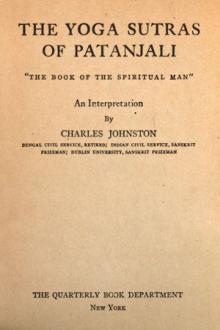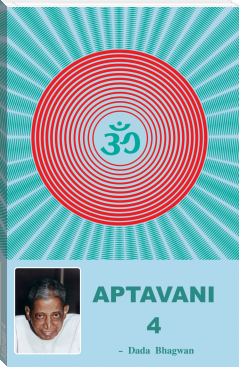The Yoga Sutras of Patanjali by Patañjali (color ebook reader .txt) 📖

- Author: Patañjali
- Performer: -
Book online «The Yoga Sutras of Patanjali by Patañjali (color ebook reader .txt) 📖». Author Patañjali
35. Faithful, persistent application to any object, if completely attained, will bind the mind to steadiness.
We are still considering how to overcome the wavering and perturbation of the psychic nature, which make it quite unfit to transmit the inward consciousness and stillness. We are once more told to use the will, and to train it by steady and persistent work: by “sitting close” to our work, in the phrase of the original.
36. As also will a joyful, radiant spirit.
There is no such illusion as gloomy pessimism, and it has been truly said that a man’s cheerfulness is the measure of his faith. Gloom, despondency, the pale cast of thought, are very amenable to the will. Sturdy and courageous effort will bring a clear and valorous mind. But it must always be remembered that this is not for solace to the personal man, but is rather an offering to the ideal of spiritual life, a contribution to the universal and universally shared treasure in heaven.
37. Or the purging of self-indulgence from the psychic nature.
We must recognize that the fall of man is a reality, exemplified in our own persons. We have quite other sins than the animals, and far more deleterious; and they have all come through self-indulgence, with which our psychic natures are soaked through and through. As we climbed down hill for our pleasure, so must we climb up again for our purification and restoration to our former high estate. The process is painful, perhaps, yet indispensable.
38. Or a pondering on the perceptions gained in dreams and dreamless sleep.
For the Eastern sages, dreams are, it is true, made up of images of waking life, reflections of what the eyes have seen and the ears heard. But dreams are something more, for the images are in a sense real, objective on their own plane; and the knowledge that there is another world, even a dream-world, lightens the tyranny of material life. Much of poetry and art is such a solace from dreamland. But there is more in dream, for it may image what is above, as well as what is below; not only the children of men, but also the children by the shore of the immortal sea that brought us hither, may throw their images on this magic mirror: so, too, of the secrets of dreamless sleep with its pure vision, in even greater degree.
39. Or meditative brooding on what is dearest to the heart.
Here is a thought which our own day is beginning to grasp: that love is a form of knowledge; that we truly know any thing or any person, by becoming one therewith, in love. Thus love has a wisdom that the mind cannot claim, and by this hearty love, this becoming one with what is beyond our personal borders, we may take a long step toward freedom. Two directions for this may be suggested: the pure love of the artist for his work, and the earnest, compassionate search into the hearts of others.
40. Thus he masters all, from the atom to the Infinite.
Newton was asked how he made his discoveries. By intending my mind on them, he replied. This steady pressure, this becoming one with what we seek to understand, whether it be atom or soul, is the one means to know. When we become a thing, we really know it, not otherwise. Therefore live the life, to know the doctrine; do the will of the Father, if you would know the Father.
41. When the perturbations of the psychic nature have all been stilled, then the consciousness, like a pure crystal, takes the colour of what it rests on, whether that be the perceiver, perceiving, or the thing perceived.
This is a fuller expression of the last Sutra, and is so lucid that comment can hardly add to it. Everything is either perceiver, perceiving, or the thing perceived; or, as we might say, consciousness, force, or matter. The sage tells us that the one key will unlock the secrets of all three, the secrets of consciousness, force and matter alike. The thought is, that the cordial sympathy of a gentle heart, intuitively understanding the hearts of others, is really a manifestation of the same power as that penetrating perception whereby one divines the secrets of planetary motions or atomic structure.
42. When the consciousness, poised in perceiving, blends together the name, the object dwelt on and the idea, this is perception with exterior consideration.
In the first stage of the consideration of an external object, the perceiving mind comes to it, preoccupied by the name and idea conventionally associated with that object. For example, in coming to the study of a book, we think of the author, his period, the school to which he belongs. The second stage, set forth in the next Sutra, goes directly to the spiritual meaning of the book, setting its traditional trappings aside and finding its application to our own experience and problems.
The commentator takes a very simple illustration: a cow, where one considers, in the first stage, the name of the cow, the animal itself and the idea of a cow in the mind. In the second stage, one pushes these trappings aside and, entering into the inmost being of the cow, shares its consciousness, as do some of the artists who paint cows. They get at the very life of what they study and paint.
43. When the object dwells in the mind, clear of memory-pictures, uncoloured by the mind, as a pure luminous idea, this is perception without exterior or consideration.
We are still considering external, visible objects. Such perception as is here described is of the nature of that penetrating vision whereby Newton, intending his mind on things, made his discoveries, or that whereby a really great portrait painter pierces to the soul of him whom he paints, and makes that soul live on canvas. These stages of perception are described in this way, to lead the mind up to an understanding of the piercing soulvision of the spiritual man, the immortal.
44. The same two steps, when referring to things of finer substance, are said to be with, or without, judicial action of the mind.
We now come to mental or psychical objects: to images in the mind. It is precisely by comparing, arranging and superposing these mind-images that we get our general notions or concepts. This process of analysis and synthesis, whereby we select certain qualities in a group of mind-images, and then range together those of like quality, is the judicial action of the mind spoken of. But when we exercise swift divination upon the mind images, as does a poet or a man of genius, then we use a power higher than the judicial, and one nearer to the keen vision of the spiritual man.
45. Subtle substance rises in ascending degrees, to that pure nature which has no distinguishing mark.
As we ascend from outer material things which are permeated by separateness, and whose chief characteristic is to be separate, just as so many pebbles are separate from each other; as we ascend, first, to mind-images, which overlap and coalesce in both space and time, and then to ideas and principles, we finally come to purer essences, drawing ever nearer and nearer to unity.
Or we may illustrate this principle thus. Our bodily, external selves are quite distinct and separate, in form, name, place, substance; our mental selves, of finer substance, meet and part, meet and part again, in perpetual concussion and interchange; our spiritual selves attain true consciousness through unity, where the partition wall between us and the Highest, between us and others, is broken down and we are all made perfect in the One. The highest riches are possessed by all pure souls, only when united. Thus we rise from separation to true individuality in unity.
46. The above are the degrees of limited and conditioned spiritual consciousness, still containing the seed of separateness.
In the four stages of perception above described, the spiritual vision is still working through the mental and psychical, the inner genius is still expressed through the outer, personal man. The spiritual man has yet to come completely to consciousness as himself, in his own realm, the psychical veils laid aside.
47. When pure perception without judicial action of the mind is reached, there follows the gracious peace of the inner self.
We have instanced certain types of this pure perception: the poet’s divination, whereby he sees the spirit within the symbol, likeness in things unlike, and beauty in all things; the pure insight of the true philosopher, whose vision rests not on the appearances of life, but on its realities; or the saint’s firm perception of spiritual life and being. All these are far advanced on the way; they have drawn near to the secret dwelling of peace.
48. In that peace, perception is unfailingly true.
The poet, the wise philosopher and the saint not only reach a wide and luminous consciousness, but they gain certain knowledge of substantial reality. When we know, we know that we know. For we have come to the stage where we know things by being them, and nothing can be more true than being. We rest on the rock, and know it to be rock, rooted in the very heart of the world.
49. The object of this perception is other than what is learned from the sacred books, or by sound inference, since this perception is particular.
The distinction is a luminous and inspiring one. The Scriptures teach general truths, concerning universal spiritual life and broad laws, and inference from their teaching is not less general. But the spiritual perception of the awakened Seer brings particular truth concerning his own particular life and needs, whether these be for himself or others. He receives defined, precise knowledge, exactly applying to what he has at heart.
50. The impress on the consciousness springing from this perception supersedes all previous impressions.
Each state or field of the mind, each field of knowledge, so to speak, which is reached by mental and emotional energies, is a psychical state, just as the mind picture of a stage with the actors on it, is a psychical state or field. When the pure vision, as of the poet, the philosopher, the saint, fills the whole field, all lesser views and visions are crowded out. This high consciousness displaces all lesser consciousness. Yet, in a certain sense, that which is viewed as part, even by the vision of a sage, has still an element of illusion, a thin psychical veil, however pure and luminous that veil may be. It is the last and highest psychic state.
51. When this impression ceases, then, since all impressions have ceased, there arises pure spiritual consciousness, with no seed of separateness left.
The last psychic veil is drawn aside, and the spiritual man stands with unveiled vision, pure serene.
The first book of Patanjali’s Yoga Sutras is called the Book of Spiritual Consciousness. The second book, which we now begin, is the Book of the Means of Soul Growth. And we must remember that soul growth here means the growth of the realization of the spiritual man, or, to put the matter more briefly, the growth of the spiritual man, and the disentangling of the spiritual man from the wrappings, the veils, the disguises laid upon him by the mind and the psychical nature, wherein he is enmeshed, like a bird caught in a net.
The question arises: By what means may the spiritual man be freed from these psychical meshes and disguises, so that he may stand forth above death, in his radiant eternalness and divine power? And the second book sets itself to answer this very question, and to detail the means in a way entirely practical





Comments (0)